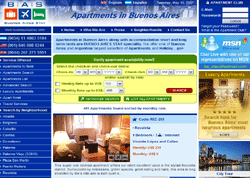Downtown Buenos Aires
El Centro or downtown is situated in the centre of Buenos Aires and is concentrated around El Obelisco. It is the business and financial centre and has shops, restaurants, cinemas, government buildings, parks, squares, and many of Buenos Aires most important monuments. It is very busy, but the many residential streets still provide very comfortable apartment blocks that are well managed and peaceful places to live. If you want to be in the tourist and commercial heart of Buenos Aires, then this is the barrio for you.
Two of the biggest avenues in the world can be found in this historic centre, 9 de Julio Avenue, which is the widest and Rivadavia Avenue, which is the longest. Much of Buenos Aires and Argentina's history is linked to this district, such as Plaza de Mayo, which has witnessed some of Argentina's greatest historical events. During the colonial period it served as a public market and its great civic relevance is conferred the important public buildings such as the Cabildo. Stroll down Avenida de Mayo, one of its most important avenues that has maintained its style throughout Argentina's golden era, troubled past and many renaissances. It was built to both link and view Plaza de Mayo and Congress Square, and many of Argentina's most famous institutions.
Florida is the main 'pedestrianised' shopping street. Along its 10 blocks you will find some of the best leather outlets, bookstores, bars, fast-food outlets, restaurants, cafeterias. Click here to see some of Downtowns Buenos Aries best budget to luxury apartments
Downtown's main attractions include:
• San MartÃn Square: Designed by the architect Carlos Thays, it has a great historical importance and it is the battlefield on which Buenos Aires residents defended themselves against the English invasion of 1807. You can find more information about this area on our website entitled 'Plaza San Martin.'
• Corrientes Avenue: This avenue holds the most important theatres and where today’s hit musicals are bill boarded.
• El Obelisco, with its 67.5 meters of height is considered to be a key symbol of Buenos Aires. It was built in 1936. Inside of it there are 200 steps that lead to the small window. It is situated on the corner of 9 de Julio and Corrientes avenues.
• Colon Opera House and Theatre: This theatre displays a French style, designed by the architect Julio Dormal, who finished in 1907. It has a capacity for 2400 guests, who are blown away by its world ranking acoustics. Its dome has a Parisian stained glass window through which lights cast great colour. It has its own museum that holds some of South America's greatest examples of indigenous ancient musical instruments, as well as workshops. It is located on the block formed by Cerrito, Viamonte, Libertad and Tucuman Streets.
• Cafe Tortoni: One of the oldest and best preserves cafes in Buenos Aires. It was founded in 1858 and frequently visited by famous characters such as Carlos Gardel and Benito Quinquela MartÃn among others. Nowadays, jazz and tango shows are a favourite. It is situated at 826 Avenida de Mayo.
• Casa Rosada: The seat of the national government since the First Council. The pink palace owes its colour to Domingo Faustino Sarmiento, who painted it with pink to symbolize the reunification of the country after the civil war between Federals whose battle colour was red, and Unitarians, whose battle colour was white. It is located at 50 Balcarce Street.
• Cabildo: This building was the starting place of the May Revolution. Its work was stopped on 1821 when the Law of Suppression of Cabildos was dictated. Today it works as the National History Museum of Buenos Aires.
• Galerias PacÃfico shopping centre: Right on Florida Street, this shopping mall is one of the best and most expensive in Buenos Aires. You can find imported brands, as well as restaurants and cafeterias. It is located on the corner of Florida Street and Cordoba Avenue.
Important information links for a fantastic Buenos Aires Stay
